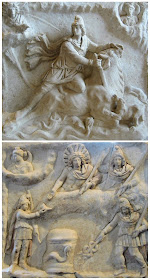 |
| Double-faced Mithraic relief. Rome, 2nd to 3rd century CE (Louvre Museum) |
The first written mention of the Vedic Mitra dates to 1400 bc. His worship spread to Persia and, after the defeat of the Persians by Alexander the Great, throughout the Hellenic world. In the 3rd and 4th centuries ad, the cult of Mithra, carried and supported by the soldiers of the Roman Empire, was the chief rival to the newly developing religion of Christianity. The Roman emperors Commodus and Julian were initiates of Mithraism, and in 307 Diocletian consecrated a temple on the Danube River to Mithra, “Protector of the Empire.”
Over the centuries—in fact, from the earliest Christian times — Mithraism has been compared to Christianity, revealing numerous similarities between the two faiths' doctrines and traditions, including as concerns stories of their respective godmen. In developing this analysis, it should be kept in mind that elements from Roman, Armenian and Persian Mithraism are utilized, not as a whole ideology but as separate items that may have affected the creation of Christianity, whether directly through the mechanism of Mithraism or through another Pagan source within the Roman Empire and beyond. The evidence points to these motifs and elements being adopted into Christianity not as a whole from one source but singularly from many sources, including Mithraism. Thus, D.M. Murdock points out, the following list represents not a solidified mythos or narrative of one particular Mithra or form of the god as developed in one particular culture and era but, rather, a combination of them all for ease of reference as to any possible influences upon Christianity under the name of Mitra/Mithra/Mithras. Mithra has the following in common with the Jesus character:
Mithra was born on December 25th of the virgin Anahita.
The babe was wrapped in swaddling clothes, placed in a manger and attended by shepherds.
He was considered a great traveling teacher and master.
He had 12 companions or "disciples."
He performed miracles.
As the "great bull of the Sun," Mithra sacrificed himself for world peace.
Mithra ascending to heaven in his solar cart, with sun symbolHe ascended to heaven.
Mithra was viewed as the Good Shepherd, the "Way, the Truth and the Light," the
Redeemer, the Savior, the Messiah.
Mithra is omniscient, as he "hears all, sees all, knows all: none can deceive him."
He was identified with both the Lion and the Lamb.
His sacred day was Sunday, "the Lord's Day," hundreds of years before the appearance
of Christ.
His religion had a eucharist or "Lord's Supper."
Mithra "sets his marks on the foreheads of his soldiers."
Mithraism emphasized baptism.
The similarities between Mithraism and Christianity have included their chapels, the term "father" for priest, celibacy and, it is notoriously claimed, the December 25th birthdate. Over the centuries, apologists contending that Mithraism copied Christianity nevertheless have asserted that the December 25th birthdate was taken from Mithraism. As Sir Arthur Weigall says: "December 25th was really the date, not of the birth of Jesus, but of the sun-god Mithra. Horus, son of Isis, however, was in very early times identified with Ra, the Egyptian sun-god, and hence with Mithra."
"Both Mithras and Christ were described variously as 'the Way,' 'the Truth,' 'the Light,' 'the Life,' 'the Word,' 'the Son of God,' 'the Good Shepherd.' The Christian litany to Jesus could easily be an allegorical litany to the sun-god. Mithras is often represented as carrying a lamb on his shoulders, just as Jesus is. Midnight services were found in both religions. The virgin mother [...] was easily merged with the virgin mother Mary. Petra, the sacred rock of Mithraism, became Peter, the foundation of the Christian Church."
Gerald Berry: Religions of the World
"Mithra or Mitra is [...] worshipped as Itu (Mitra-Mitu-Itu) in every house of the Hindus in India. Itu (derivative of Mitu or Mitra) is considered as the Vegetation-deity. This Mithra or Mitra (Sun-God) is believed to be a Mediator between God and man, between the Sky and the Earth. It is said that Mithra or [the] Sun took birth in the Cave on December 25th. It is also the belief of the Christian world that Mithra or the Sun-God was born of [a] Virgin. He travelled far and wide. He has twelve satellites, which are taken as the Sun's disciples [...] [The Sun's] great festivals are observed in the Winter Solstice and the Vernal Equinox—Christmas and Easter. His symbol is the Lamb [...] "
Swami Prajnanananda: Christ the Saviour and Christ Myth.
D.M. Murdock concludes, that ""Christmas" is the birth not of the "son of God" but of the sun. Indeed, there is much evidence—including many ancient monumental alignments — to demonstrate that this highly noticeable and cherished event of the winter solstice was celebrated beginning hundreds to thousands of years before the common era in numerous parts of the world. The observation was thus provably taken over by Christianity, not as biblical doctrine but as a later tradition in order to compete with the Pagan cults, a move we contend occurred with numerous other "Christian" motifs, including many that are in the New Testament."
For three days, on December 22nd , 23rd, and 24th, the Sun rises on the
exact same declinational degree. This is the only time in the year
that the Sun actually stops its movement in the sky. On
the morning of December 25th the Sun moves northward again, beginning its
annual journey back into the Northern Hemisphere, ultimately bringing the
spring. By the ancients, anything steadily moving all year long that suddenly stops moving for
three days was considered to have died. Therefore, God’s Sun who was dead
for three days, moves one angular minute northward on December 25th and is symbolically
born again (see also HERE + HERE).
 |
| Even the darkest night will end, And the sun will rise again. Jalāl ad-Dīn Muhammad Rūmī (1207-1273) |
